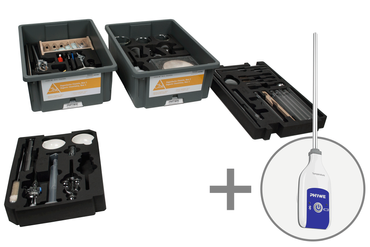Principle
Again here, the reaction belongs to the class of nucleophilic substitutions, in which both the OH- ions and the water molecules act as reactants. The splitting of the ester also takes place without the addition of alkali, but this accelerates the reaction and
simultaneously causes the colouration of the indicator.
This reaction allows the reversibility of chemical reactions to be taken as a theme. Furthermore a more detailed discussion of the chemical equilibrium can be performed, you can also discuss the influence of the reactants on the equilibrium.
Learning objectives
- The ester formation is an equilibrium reaction. Esters can therefore be changed back to the products they were prepared from.
- The reverse reaction, which occurs quicker in the presence of OH- ions, can be detected with an indicator since a carboxylic acid is formed.
Benefits
- Easy teaching and efficient learning by using interactive experimentation PHYWE-Software
- Experiment is part of a complete solution set with experiments for the topic Organic Chemistry matched with international curriculum: all topics are covered


